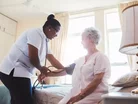Aging populations are a captive market for the medical device industry

With 23% of the population currently aged 60 or older, Europe is home to a relatively aged population.
This is a result of the higher life expectancy and decreased birth and mortality rates.
By 2030, more than 25% of the population in Europe will be 60 or older. The growing senior population is an important growth driver for health care.
Of course, it is not just Europe where the population is aging.
According to a 2015 review by the World Health Organisation (WHO) approximately one in nine people is aged 60 years or over.
In Japan, the challenge of population ageing is particularly pronounced, as people over the age of 65 years account for 23% of the population while people under the age of 15 years only account for 13% of the population.
According to Johnson & Johnson, “people over the age of 65 years use approximately seven times more health care-related products and services than younger people”.
This is good news for the medical devices industry.
The medical devices industry is a major employer in Europe, employing 575,000 people in the EU.
Total sales amount to €100bn, according to the European Commission.
SEE ALSO:
-
The FDA launches new guidance surrounding the development of new health-tech
-
Apple’s FDA-cleared Apple Watch band underlines its growing healthcare focus
The sector represents some 25,000 companies, of which 95% are Small and Medium-sized Enterprises (SMEs).
“From a macroeconomic standpoint, certainly, we have an aging population,” said Peter Huie, VP Supply Chain & Facilities, Millstone Medical.
“We have 18,000 Americans alone that turn 65 every day for the next 18 years.”
“So, there's certainly a captive audience for our business to grow.”
Indeed, according to the US Census Bureau, the majority of the American Baby Boomer population turns 65 between 2010 and 2020.
That number, at its height, will account for 28% of the total population.
As medical device innovation progresses to meet the challenges of an aging population, many regulatory bodies are struggling to keep apace.
According to an Emergo survey of Quality Assurance/Regulatory Affairs professionals published in January 2015, regulatory compliance is becoming more difficult for medical device companies around the globe.
In fact, over 35% of respondents reported that obtaining regulatory approval in the US is more difficult today than it was one year ago.
“The ever-changing landscape of FDA requirements, ISO requirements – here's always a challenge in making sure that you're up to date with meeting those requirements,” said Tom Williams, General Manager, Millstone Medical.
“Balancing those and the 50 different customers we have and the 50 different requirements that come with those customers, and being able to balance it all to ensure that we're providing a robust service is a challenge.”



